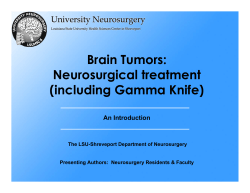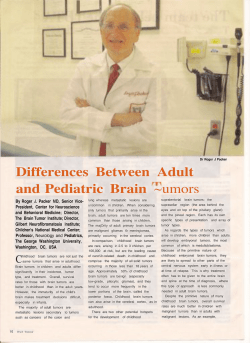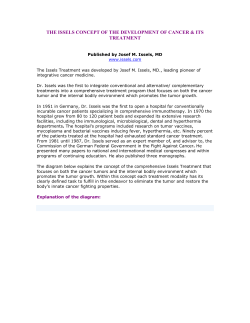
Retroperitoneal Leiomyosarcoma: A Case Report and Review of the Literature Case Report
J Soc Colon Rectal Surgeon (Taiwan) December 2008 Case Report Retroperitoneal Leiomyosarcoma: A Case Report and Review of the Literature Hua-Ching Lin1 Ming-Teng Chung2 1 Division of Colorectal Surgery, Department of Pathology, Chen Hsin Rehabilitation Medical Center, Taipei, Taiwan 2 Key Words Retroperitoneum; Leiomyosarcoma Soft tissue sarcomas constitute a heterogeneous group of neoplasms of various histologies and comprise less than one per cent of all adult malignancies. They occur at all anatomic body sites, and about 10%-20% of soft tissue sarcomas arise from the retroperitoneum. Leiomyosarcoma, a rare malignancy of smooth muscle, represents 10%-37% of all soft tissue sarcomas arising in the retroperitoneum. Retroperitoneal leiomyosarcoma occurs most commonly in the fifth to seventh decades. There has no known predilection for race or gender. The most common clinical picture at presentation in reported cases includes back pain, weight loss, and increase abdominal girth. Complete surgical resection is the treatment of choice. Adjuvant therapy with radiation is commonly recommended for patient with high-grade resected tumors. The benefits of adjuvant chemotherapy remain controversial. Treatment of this rare neoplasm is complicated by the large size of the tumor at diagnosis and frequent presence of metastases; therefore, prognosis is poor. Herein, we present a 68-year-old woman with increasing abdominal girth, intermittent abdominal discomfort, a palpable abdominal mass, and a 6 kg weight loss over 2 months. Computed tomography of the abdomen disclosed a huge retroperitoneal tumor. Leiomyosarcoma was proved after surgery. Then, she has received radiotherapy. She is currently alive 5 months after diagnosis without recurrence or metastasis. [J Soc Colon Rectal Surgeon (Taiwan) 2008;19:123-127] S arcomas are rare malignant tumors that arise from mesenchymal tissue at any body site. They represented only 0.64 percent of all new cancers in United States in 2006.1 Ten to twenty percent of soft tissue sarcomas occur in the retroperitoneum.2-6 In a population-based series reported in the Surveillance, Epidemiology, and End Results (SEER) database, the average annual incidence of retroperitoneal sarcomas was approximately 2.7 cases per million population.7 Leiomyosarcoma, liposarcoma, and fibrosarcoma are the most common histologic types of retroperitoneal sarcomas.2-6 The retroperitoneum provides a widely expansible anatomic location for tumors arising there, and these tumors often become very large before symptoms manifest.6 The median size at diagnosis is approximately 15 cm.8 Complete tumor resection is the treatment of choice but is rarely feasible due to invasion of adjacent structures by tumors,6 and is perhaps the most important factor in survival outcome.9,10 Although adjuvant radiotherapy is associated with a reduced risk of local recurrence, there has generally been no suggestion of an impact on survival. Adjuvant chemotherapy has shown no significant benefits. Besides surgical treatment, another key factor related to prognosis is the grade of the tumor. We report a woman with a huge retroperitoneal leiomyosarcoma. Received: May 2, 2008. Accepted: September 29, 2008. Correspondence to: Dr. Hua-Ching Lin, 45, Cheng Hsin Street, Taipei, Taiwan. Tel: +886-2-2826-4400; E-mail: linhua@ms11.hinet. net 123 124 Hua-Ching Lin, et al. J Soc Colon Rectal Surgeon (Taiwan) December 2008 Case Report A 68-year-old married female was in good health until 2007, when she was admitted to our department with a 2- month history of increasing abdominal girth, intermittent abdominal discomfort, a palpable abdominal mass, and a 6 kg weight loss. Physical examination revealed a 15cm palpable mass over the left middle portion of the abdomen. KUB revealed a displaced transverse colon and a soft tissue density in the left middle portion of the abdomen. Computed tomography (CT) of the abdomen also revealed an approximately 14 ´ 12 ´ 10 cm heterogeneous, retroperioneal mass with contrast enhancement, which did not envelope any major organ or vessel, and calcification (Fig. 1). She underwent an exploratory laparotomy with resection of a 430 gm retroperitoneal mass. The tumor was not attached to the duodenum and other great vessels. Pathologic examination revealed a high-grade leiomyosarcoma with high cellularity, spindle-shaped stromal cells arranged in fascicles, about 20 mitoses per 10 HPF, focal myxoid degeneration, necrosis, and some pleomorphic nuclei in the tumor cells (Fig. 2). The spindle tumor cells exhibited positive staining for HHF-35, and negative staining for CD-117, CD-34 and S-100. The patient received adjuvant radiother- Fig. 1. Abdominal CT showing a bulky heterogeneous retroperitoneal tumor. Fig. 2. Representative field of leiomyosarcoma with high cellularity, spindle-shaped stromal cells, and mitoses (H & E stain, ´ 100). apy at 5400 CGY. She is currently alive 5 months after diagnosis without recurrence or metastasis. Discussion Leiomyosarcomas are rare tumors that may arise from any smooth muscle source. They are reported to represent 10%-37% of all soft tissue sarcomas arising in the retroperitoneum.11-13 Retroperitoneal leiomyosarcoma occurs most commonly in the fifth to seventh decade.2-5 The age of our patient is consistent with previous reports. In Todd et al’s report, the patients’ ages at presentation ranged from 46-73 years, with a mean age of 61.4. However, there is no known predilection for race or gender.6 Retroperitoneal tumors typically have vague presenting symptoms. These tumors are provided with a well-concealed, widely expansible area, leading to the development of large masses with local and distant metastases before the patient becomes symptomatic. Todd et al reported that the most common clinical picture of retroperitoneal sarcoma cases at presentation includes back pain and weight loss (37.5% of patients with either symptom), with fatigue (25%), increased Vol. 19, No. 4 abdominal girth (12.5%), and fever or night sweats (12.5%) also noted.6 These patients exhibited symptoms for an average 3.5 months before presentation. Twenty-five percent of patients had masses discovered incidentally during routine examination or abdominal surgery (cholecystectomy). The studies of Cody et al and Braasch et al both reported abdominal pain and weight loss were the most common symptoms.3,14 The clinical presentation of our case was consistent with these reports. The diagnosis of retroperitoneal tumor is aided by imaging studies which contribute greatly to delineating the size, location, and character of a mass. Todd et al pointed out that CT was the preferred method for evaluation of a known mass prior to exploratory laparotomy.6 A leiomyosarcoma on CT and magnetic resonance imaging is typically a nonfatty, irregularly marginated, heterogeneous mass without calcification. Ultrasound and angiography may be useful in delineating tumor vessels or vascular infiltration if these are suspected from other studies.14,15 Surgery is the main treatment factor in the outcome of retroperitoneal leiomyosarcoma.8,9,13 Complete surgical resection with at least 3 cm margins is the treatment of choice but is rarely feasible due to invasion of adjacent structures by the tumor.6,16,17 Erzen et al pointed out that some tumors might need to be resected en bloc with adjacent structures in order to obtain free margins.13 In that report, at least one organ was resected completely or partially in 118 patients. The most frequent organ resected was the bowel. The feasibility of complete resection is one of the important factors influencing the survival of patients.8,18 Curative surgery is difficult with large retroperitoneal sarcomas and those in close proximity to vital structures and involving adjacent organs.9 The rate of complete resection has varied in the literature from 38% to 95%.3,4,16,18 Lipoarcoma, leiomyosarcoma and malignant fibrous histiocytoma represented 66% of the tumors in Stoeckle et al’s review of 165 cases of retroperitoneal sarcoma. Complete excision was achieved in 94 of 145 patients who had no metastasis. The actuarial overall 5-year rate was 46%. The main prognostic factors for survival were initial metastasis and surgery.8 Aggressive surgery remains mandatory in retroperitoneal leiomyosarcoma. Retroperitoneal Leiomyosarcoma 125 There are few studies offering evidence of effective radiotherapy for retroperitoneal leiomyosarcoma. In nonrandomized retrospective series, the addition of adjuvant radiotherapy after surgical resection is associated with a reduced risk of local recurrence, and a longer recurrence-free interval, but there has generally been no suggestion of an impact on survival.5,8,12,19,20 Svarvar et al reviewed 225 patients with nonvisceral soft tissue leiomyosarcomas, and there was no significant difference between complete surgical resection with or without adjuvant radiotherapy in the long-term prognosis. Multivariate analysis of the cases showed that a higher grade malignancy, large tumors, and deep tumors were correlated significantly with decreased metastasis-free survival. .Inadequate local treatment was correlated with local recurrence, and a high grade of malignancy was correlated with decreased overall survival.21 With the exception of childhood soft tissue sarcomas such as rhabdomyosarcoma and extraskeletal Ewing’s sarcoma,22,23 the benefits of adjuvant chemotherapy for soft tissue sarcoma remain controversial. The use of adjuvant chemotherapy following surgical resection for retroperitoneal leiomyosarcoma is not a standard approach.6,24 Singer et al’s study of a series of 183 patients with truncal or retroperitoneal sarcomas suggests a poor outcome (3 to 4.6-fold increase in the risk of death) for patients who received either preoperative or postoperative chemotherapy.24 The prognosis of retroperitoneal leiomyosarcoma varies significantly according to the grade of the tumor. In Bautista et al’s retrospective review of 23 patients with retroperitoneal sarcomas, liposarcomas were the most common pathology (61%) and leiomyosarcomas were second (30%).9 Low-grade sarcomas overall accounted for 62 per cent of the total group. Low-grade tumors independent of the histologic type exhibited good prognosis for long-term survival with a median survival of 44 months. In contrast, intermediate- or high-grade tumors were associated with a median survival of only 9 months (P < 0.02). Tumor grade was identified as an important prognostic factor with low-grade retroperitoneal sarcomas being associated with significantly longer median survival times. Liposarcomas were associated with a median survival time of 33 months and leio- 126 Hua-Ching Lin, et al. myosarcomas 24 months. The tumor histologic type independent of grade did not show a significant survival difference. In many other studies, the histologic type independent of tumor grade was not shown to be important for prognostic evaluation.8,10,25 In Stoeckle et al’s study, 84% of the tumors (165 cases) were high or intermediate grade. There was no significant survival difference between different histologic type tumors. A high grade affected local recurrence, metastatic recurrence, and survival.8 J Soc Colon Rectal Surgeon (Taiwan) December 2008 13. 14. 15. 16. References 17. 1. Jemal A, Siegel R, Ward E, Murray T, Xu J, Thun MJ. Cancer statistics, 2007. CA Cancer J Clin 2007;57:43-66. 2. Adam Y, Osland J, Harvey A, Reif R. Primary retroperitoneal soft-tissue sarcomas. J Surg Oncol 1984;25:8-11. 3. Cody HS, Turnball AD, Fortner JG, Hajdu SI. The continuing challenge of retroperitoneal sarcomas. Cancer 1981;47: 2147-52. 4. McGrath P, Neifeld JP, Lawrence W, DeMay RM, Kay S, Horsley JS 3rd, Parker GA. Improved survival following complete excision of retroperitoneal sarcomas. Ann Surg 1984; 200:200-4. 5. Catton CN, O’Sullivan B, Kotwall C, Cummings B, Hao Y, Fornasier V. Outcome and prognosis in retroperitoneal soft tissue sarcoma, Int J Radia Oncol 1994;29:1005-10. 6. Todd, CS, Michael H, and Sutton G. Retroperitoneal leiomyosarcoma: eight cases and a literature review. Gynecol Oncol 1995;59:333-7. 7. Dalal KM, Kattan MW, Antonescu CR, Brennan MF, Singer S. Subtype specific prognostic nomogram for patients with primary liposarcoma of the retroperitoneum, extremity, or trunk. Ann Surg 2006;244:381-91. 8. Stoeckle E, Coindre JM, Bonvalot S, Kantor G, Terrier P, Bonichon F, Nguyen Bui B. Prognostic factors in retroperitoneal sarcoma: a multivariate analysis of a series of 165 patients of the French Cancer Center Federation Sarcoma Group. Cancer 2001;92:359-68. 9. Bautista N, Su W, and O’Connell TX. Retroperitoneal softtissue sarcomas: prognosis and treatment of primary and recurrent disease. Am Surg 2000;66:832-6. 10. Storm FK, and Mahvi DM. Diagnosis and management of retroperitoneal soft-tissue sarcoma. Ann Surg 1991;214:2-10. 11. Lawrence W. Operative management of soft tissue sarcomas: Impact of anatomic site. Semin Surg Oncol 1994;10:340-6. 12. Heslin JM, Lewis JL, Nadler E, Newman E, Woodruff JM, 18. 19. 20. 21. 22. 23. 24. 25. Casper ES, Leung D, Brennan MF. Prognostic factors associated with long-term survival for retroperitoneal sarcoma: Implications for management. J Clin Oncol 1997;15:2832-9. Erzen D, Sencar M, and Novak J. Retroperitoneal sarcoma: 25 years of experience with aggressive surgical treatment at the institute of oncology, Ljubljana. J Surg Oncol 2005;91: 1-9. Braasch JM, and Mon AB. Primary retroperitoneal tumors. Surg Clin North Am 1967;47:663-77. Hartmann DS, Hayes WS, Choyke PL, Tibbetts GP. Leiomyosarcoma of retroperitoneum and inferior vena cava: Radiologic and pathologic correlation. RadioGraphics 1992; 12:1203-20. Glenn J, Sindelar WF, Kinsella T, Glatstein E, Tepper J, Baker A, Sugarbaker P, Brennan MF, Seipp C. Results of multimodality therapy of respectable soft tissue sarcomas of the retroperitoneum. Surgery 1985;97:316-24. Baker CC, and Gusberg RJ. Retroperitoneal soft tissue sarcomas: A continuing surgical challenge. Conn Med 1986;50: 217-20. Ferrario T, and Karakousis CP. Retroperitoneal sarcomas: grade and survival. Arch Surg 2003;138:248-51. Jones JJ, Catton CN, O’Sullivan B, Couture J, Heisler RL, Kandel RA, Swallow CJ. Initial results of a trial of preoperative external-bean radiation therapy and postoperative brachytherapy for retroperitoneal sarcoma. Ann Surg Oncol 2002; 9:346-54. Mendenhall WM, Zoltecki RA, Hochwald SN, Hemming AW, Grobmyer SR, Cance WG. Retroperitoneal soft-tissue sarcoma. Cancer 2005;104:669-75. Svarvar C, Bohling T, Berlin O, Gustafson P, Folleras G, Bjerkehagen B, Domanski HA, Sundby Hall K, Tukiainen E, Blomqvist C. Clinical course of nonvisceral soft tissue leiomyosarcoma in 225 patients from the Scandinavian Sarcoma Group. Cancer 2007;109:282-91. Arndt C, Hawkins D, Anderson JR, Breitfled P, Womer R, Meyer W. Age is a risk factor for chemotherapy-induced hepatopathy with vincristine, dactinomycin, and cyclophosphamide. J Clin Oncol 2004;22:1894-901. Castex MP, Rubie H, Stevens MC, Escribano CC, de Gauzy JS, Gomez-Brouchet A, Rey A, Dalattre O, Oberlin O. Extraosseus localized ewing tumors: improved outcome with anthracyclines– the French Society of Pediatric Oncology and International Society of Pediatric Oncology. J Clin Oncol 2007;25:1176-82. Singer S, Cirsib JM, Demetri GD, Healey EA, Marcus K, Eberiein TJ. Prognostic factors predictive of survival for truncal and retroperitoneal soft-tissue sarcomas. Ann Surg 1995;221:185. Jaques DP, Coit DG, Hajdu SI, Brennan MF. Management of primary and recurrent soft-tissue sarcoma of the retroperitoneum. Ann Surg 1990;212:51-9.
© Copyright 2025














